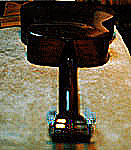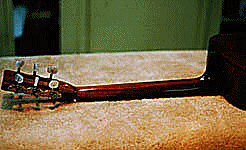|
| Hardware Parts Accessories |
|---|
| Electronics |
| Guitar Wood and Kits |
| Tools |
In a lapse of my normally thorough photographic documentation of interesting jobs, I failed this time to take adequate photos of the process, but this was an interesting job. The tenor is owned by Brad Klein of NYC. He came to me with some ideas of his own, we blended these with some of mine, and this is what we came up with.
Brads truss rod design was interesting in that he made a box of graphite, a la Martin square bar truss rods, with a mahogany core. Mahogany would not have been my choice for the core, but hey, it was his guitar and I couldn't say that it wouldn't work, so we used it. The truss rod design did dictate my approach to carving the neck. I intended to give the neck the Martin "look", (in my opinion all work on Luthier grade instruments ought to be faithful to the makers style), so I decided on giving it an ebony rod era styling, i.e. heavier than if a metal truss rod were used.
As a tenor, this guitar had 23 inch scale. Unless we wanted to move the bridge location (or have an odd looking long neck) , the new neck would have to be constructed on a 23 inch scale. Brad had heard of someone who had shifted the bridge location, but for cleaner appearance, and no compelling reason not to, we went with the 23 inch scale and a rosewood fretboard. After a little back and forth, it was agreed that we would have a slotted headstock, with modern Schaller tuners. The original bridge was of course not as wide as a six string bridge would be, but spread of the x braces under the top was wide enough to accommodate a 2 1/8" string spacing, so we were able to use a stock rosewood Martin bridge. The neck width at the nut is 1 3/4".
A purist can look at the fretboard and see one minor deviation (a shameful oversight on my part) from standard Martin styling, but I like to the think that most people will see this guitar and wonder if it was sent back to Nazareth for a modification. The neck, with Brads truss rod is quite stable and the little thing sounds great. So if you're looking for a great travel guitar and you have an old tenor lying around, consider a neck conversion. |

 Brad had already removed the neck. He had some woodworking experience and in fact had also made a graphite and mahogany truss rod for the neck. Apparently, some years back he had worked in a shop in which Ned Steinberger (Steinberger Guitars) had been also working. He got some of Neds graphite and made a truss rod which he intended to use on his conversion neck.
Brad had already removed the neck. He had some woodworking experience and in fact had also made a graphite and mahogany truss rod for the neck. Apparently, some years back he had worked in a shop in which Ned Steinberger (Steinberger Guitars) had been also working. He got some of Neds graphite and made a truss rod which he intended to use on his conversion neck.


